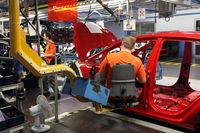Ford "Happy Seat" Improves Life On The Assembly Line
BRENTWOOD, UNITED KINGDOM – May, 2011: Over 100 years after Henry Ford pioneered the moving assembly line, Ford is still refining its founder's industry-changing innovation.
To address issues such as an ageing workforce and the physical tolls of long-term working on the line, Ford convened a team of occupational physicians, production specialists, labourgroups and representatives for disabled employees to improve ergonomics, safety and productivity.
This led to the creation of the “Happy Seat” – an ingenious swivel chair attached to a rod-shaped suspension. It enables workers to sit in comfort on the production line while assembling cars. The seat allows workers to sit and glide into the car while fitting pedal boxes, for example, instead of bending over. The first "Happy Seat" was installed at the workstation wiring roof antennae at Genk, Belgium, in 1998 with Cologne’s "Happy Seat" following in 2002. Today, "Happy Seats" are also in use at Valencia, Spain, and Saarlouis, Germany.
“It’s called the "Happy Seat" for a good reason – it makes a tough job easier for workers in our plants,” says Eilis Carey, senior ergonomist for Ford of Europe. “Operations which previously required awkward postures to be maintained for prolonged periods can now be performed in a seated position with adequate lumbar support.”
The "Happy Seat" allows employees with more experience to stay integrated in existing work groups while health and productivity levels are retained. “The ergonomics of the workstation are improved and operators’ discomfort and fatigue are reduced, leading to reduced injuries and illnesses, fewer lost work days, and improved quality of the operations,” Carey said.
Martin Chapman, operations manager in Cologne plant, where Ford produces the Fiesta, adds: “Employees just push themselves back and forth and the chair swings in and out of the cabin – very simply and not requiring much physical effort. And their back feels fine, allowing employees to remain in employment longer to the benefit of Ford.”
Given the ageing European population and increases in retirement ages in some countries, Ford’s “Happy Seat” has become especially relevant to the 21st Century workplace.
Further measures employed by Ford to ensure production line workers’ health include movable platforms to raise vehicle chassis to different heights at various workstations, preventing excessive stretching and bending by employees; virtual software programs to design the most ergonomic production processes; and Santos, a computerisedavatar or character that performs actions in the virtual world to help Ford improve quality, safety and ergonomics for its assembly line employees.



